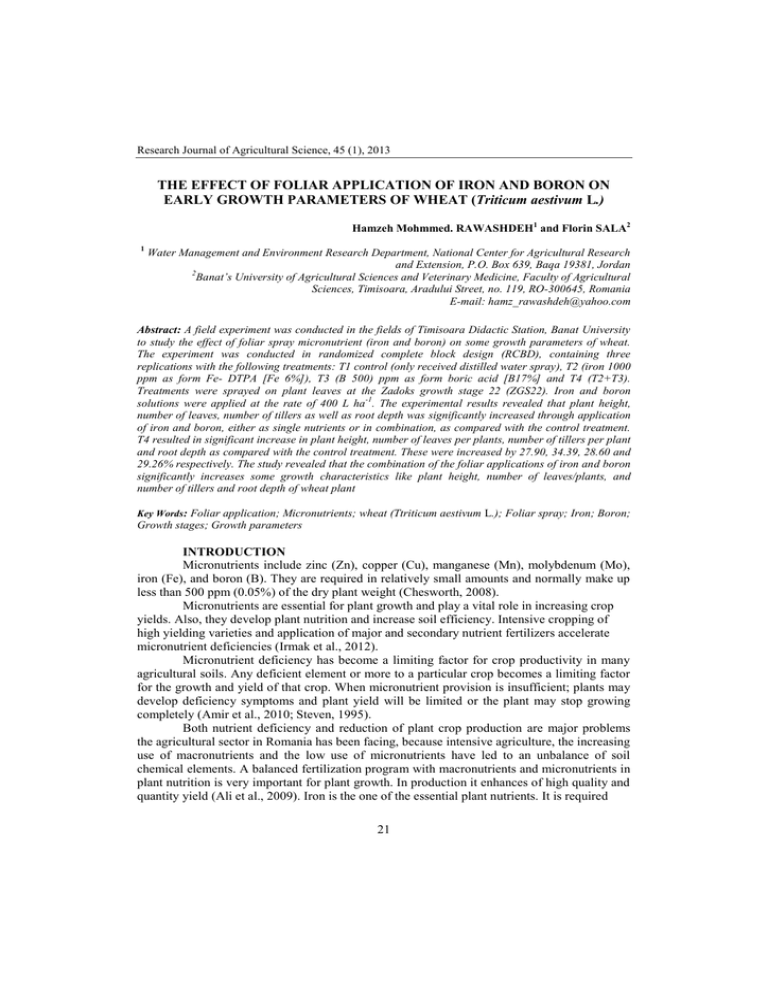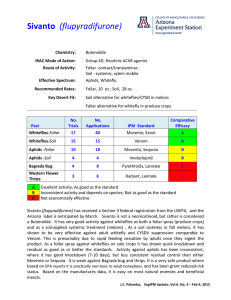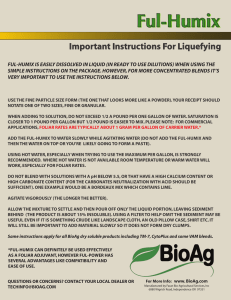Document
advertisement

Research Journal of Agricultural Science, 45 (1), 2013 THE EFFECT OF FOLIAR APPLICATION OF IRON AND BORON ON EARLY GROWTH PARAMETERS OF WHEAT (Triticum aestivum L.) Hamzeh Mohmmed. RAWASHDEH1 and Florin SALA2 1 Water Management and Environment Research Department, National Center for Agricultural Research and Extension, P.O. Box 639, Baqa 19381, Jordan 2 Banat’s University of Agricultural Sciences and Veterinary Medicine, Faculty of Agricultural Sciences, Timisoara, Aradului Street, no. 119, RO-300645, Romania E-mail: hamz_rawashdeh@yahoo.com Abstract: A field experiment was conducted in the fields of Timisoara Didactic Station, Banat University to study the effect of foliar spray micronutrient (iron and boron) on some growth parameters of wheat. The experiment was conducted in randomized complete block design (RCBD), containing three replications with the following treatments: T1 control (only received distilled water spray), T2 (iron 1000 ppm as form Fe- DTPA [Fe 6%]), T3 (B 500) ppm as form boric acid [B17%] and T4 (T2+T3). Treatments were sprayed on plant leaves at the Zadoks growth stage 22 (ZGS22). Iron and boron solutions were applied at the rate of 400 L ha -1. The experimental results revealed that plant height, number of leaves, number of tillers as well as root depth was significantly increased through application of iron and boron, either as single nutrients or in combination, as compared with the control treatment. T4 resulted in significant increase in plant height, number of leaves per plants, number of tillers per plant and root depth as compared with the control treatment. These were increased by 27.90, 34.39, 28.60 and 29.26% respectively. The study revealed that the combination of the foliar applications of iron and boron significantly increases some growth characteristics like plant height, number of leaves/plants, and number of tillers and root depth of wheat plant Key Words: Foliar application; Micronutrients; wheat (Ttriticum aestivum L.); Foliar spray; Iron; Boron; Growth stages; Growth parameters INTRODUCTION Micronutrients include zinc (Zn), copper (Cu), manganese (Mn), molybdenum (Mo), iron (Fe), and boron (B). They are required in relatively small amounts and normally make up less than 500 ppm (0.05%) of the dry plant weight (Chesworth, 2008). Micronutrients are essential for plant growth and play a vital role in increasing crop yields. Also, they develop plant nutrition and increase soil efficiency. Intensive cropping of high yielding varieties and application of major and secondary nutrient fertilizers accelerate micronutrient deficiencies (Irmak et al., 2012). Micronutrient deficiency has become a limiting factor for crop productivity in many agricultural soils. Any deficient element or more to a particular crop becomes a limiting factor for the growth and yield of that crop. When micronutrient provision is insufficient; plants may develop deficiency symptoms and plant yield will be limited or the plant may stop growing completely (Amir et al., 2010; Steven, 1995). Both nutrient deficiency and reduction of plant crop production are major problems the agricultural sector in Romania has been facing, because intensive agriculture, the increasing use of macronutrients and the low use of micronutrients have led to an unbalance of soil chemical elements. A balanced fertilization program with macronutrients and micronutrients in plant nutrition is very important for plant growth. In production it enhances of high quality and quantity yield (Ali et al., 2009). Iron is the one of the essential plant nutrients. It is required 21 Research Journal of Agricultural Science, 45 (1), 2013 For a healthy growth and life cycle completion (Ali, 2012). Fe plays a role in many plant functions in plant growth and development. This function includes chlorophyll synthesis, thylakoid synthesis and chloroplast development (Masoud et al., 2011). It also plays a role in energy transfer within the plant, it is a constituent of certain enzymes and proteins, it has an essential role in plant growth (Ali, 2012), and it enters root cells, and is involved in nitrogen fixation. Fe plays an active role in several enzymatic activities of photosynthesis as well as respiration. The prevalent problem in the universal agricultural districts and management of B nutrition is challenged by abrupt incidences of B absence (Wimmer et al., 2013). B is an important micronutrient required for plant growth and yield (Soomro et al., 2011). A main function of boron is correlated to cell wall formation, nitrogen fixation, sugar transportation, and phenol, nucleic acid, membrane stability carbohydrate, indolic acetic acid (IAA) metabolism. Flower retention and pollen formation and germination also are affected by boron. B deficit affects the reproductive yield more than biomass yield. Seed and grain production are reduced with low boron supply still in the absence of any observable indication of deficiency symptoms and so the requirement of B for reproductive increase appears to be more for reproductive development than for vegetative growth (Nalini et al., 2013). Foliar spraying of microelements is very beneficial when the roots cannot provide nutrients (Babaeian et. al., 2011; Parinaz et al., 2012). Also, soil pollution would be a major problem for micronutrients soil application, because people are concerned about the environment and plant leaves uptake nutrients better than soil application (Bozorgi et al., 2011). Foliar application of micronutrients on wheat crop has had significant positive effects on plant growth and yield parameters. (Ai-Qing et al., 2011; Ali, 2012; Masoud et al., 2012; Nadim et al., 2012). The main object of this study was to determine the effect of foliar feeding with iron and boron either as single nutrient or in combination on the early growth parameters of wheat. MATERIAL AND METHODS The field experiment was conducted during the growing season 2012-2013 to investigate the effect of Fe and B application either as single nutrient or in combination on Plant height, Number of tillers, number of leaves, root depth of wheat, at the Didactic Station, Banat University, Timisoara, in west Romania. The experimental site is located at 45°46′ N latitude, 21°25′ E longitude with an altitude of 85 m above sea level. Composite soil sample of surface soil (0-25cm depth) was taken after the site had been prepared. Filled inside packs were transferred to the laboratory for the determination of its physical and chemical properties. The soil was air dried, passing through a 2 mm sieve so as to obtain a more homogeneous soil sample. Available Fe was determined by ammonium oxalate 0.2 N extractions (Pouget et al., 1972). Soil available B was extracted by hot water (Berger et al., 1939) and measured by carmine colorimetric method (Hatcher et al., 1950). The physical and chemical properties of the soils are presented in Table 1.The experiment was laid out in randomized completely block design (RCBD) with three replications. Seeds were sown through drills at a 15 cm distance between rows. A seed rate 270 kg ha-1 of “alex” wheat variety was used. The size of each plot was 10.0 m long and 3.0 m wide. A buffer zone of 2.0 m spacing was given between plots. The same dose of NPK fertilizer was applied for all treatments at 4 weeks after sowing in the form of complex 150:100:100 respectively at the rate of 360 kg ha -1. Foliar solutions were sprayed with a hand held spray bottle at the rate of 400 L ha-1 on plant foliage when wheat plants were 22 Research Journal of Agricultural Science, 45 (1), 2013 in Zadoks Growth stage 22 (ZGS22) (Zadoks et al., 1974). Foliar application included control treatment (distilled water spray) T1), iron 1000 ppm as Fe-DTPA Table (1) Chemical and physical properties of soil experiment PH 6.33 EC Hums Total-N dS.m-1 % % 0.31 3.22 2.25 P K Fe B (ppm) 11.23 184.49 F.C Soil texture % 26.72 0.58 26.60 Clay (Fe 6%) (T2), boron 500 ppm as form boric acid (B17%) (T3) and (T2+T3) (T4).Ten plants were harvested softly from each plot at three weeks after spraying treatments. The soil was washed off root under running tap water; the plant depth and the root depth were immediately measured. The number of tillers and number of leaves also accounted. Data on plant height, number of tillers, number of leaves and root depth were recorded and analyzed statistically using analysis of variance (ANOVA) procedures using the computer package MSTAT-C (Russell, 1986). Differences between means were compared by LSD at 5% level of significant. RESULTS AND DISCUSSIONS Analysis of variance indicated that plant height was significantly affected by foliar application of Fe and B, both alone and combined. The highest plant height 16.50 cm was achieved by foliar application of T4 (Fe+B) followed by T3 and T2 treatments, and the lowest plant height 12.90 cm was obtained from T1 (Figure 1). There was no difference between T3 and T4 foliar application in plant height. Compared with control, plant height increased 27.90, 23.80 and 16.05 % respectively, by the employment of T4, T3 and T2 respectively. Fe has a structural role in chlorophyll, energy transfer within the plant and enters in root cells and B is necessary in the formation of plant cells, sugar transportation, IAA, formation and germination. These nutrients can be simply sprayed on plant leaf. Therefore, cell wall formation, leaves chlorophyll concentration and IAA increased due to micronutrient foliar application, which in turn, leads to an increase in plant height and production (Abbas et al., 2009; Ali, 2012; Masoud et al, 2012; Uddin et al., 2008). The results showed that application of Fe and B (alone or together) had significantly increased the number of leave/ plants compared with control (Figure 2). The results indicated that the highest number of leave per plant was obtained when plants were treated with T4 (Fe+B). Number of leave per plants increased 34.39% with T4 followed by 27.47% with T3 and 10.31% with T2 as compared with control. There was no difference between T4 and T3 foliar application treatments on number of leave per plants. Fe and B are play role in physiological processes such as chlorophyll content, water and nutrients absorption, nucleic acids, IAA, cell division and cell elongation which in turn effect on plant growth, therefore reflected positive effect on increasing the number of leaves per plant (El-Fouly et al., 2011; Masoud et al., 2012). They reported that foliar application of micronutrients improves the growth parameters, nutrients uptake and yield of wheat. Application of Fe, and B both alone and together significantly increased number of tillers per plant (Figure 3). Number of tillers per plant increased 28.59% over control by the employments of T4, T3 and T2. There was no significant difference between T4, T3, and T2 treatment in number of tillers per plant. Similar results were obtained by (Nadim et al., 2012; 23 Research Journal of Agricultural Science, 45 (1), 2013 Yassen et al., 2010), they reported that application of iron and boron significantly increased the number of tillers over control. Results showed that root depth was significantly affected by foliar application of Fe and B independently and together (Figure 4). The highest root depth 12.68 cm was due to foliar application of T4 (B) followed by T3 and T2 foliar treatments, and the lowest root depth 9.81 cm was achieved from T1 (control). Comparing with control, root depth increased 29.26, 19.27 and 8.46 % respectively due to the utilization of T4, T3 and T2 respectively. Fe and B effect on chlorophyll content, water and nutrients absorption, IAA, cell division and cell elongation which in turn improve plant growth parameters, therefore reflected positive effect on increasing the root depth These results coincide with (El-Fouly et al., 2011) who reported that foliar application of micronutrients could be practical for improving the nutrient position, root features and physiological execution of wheat plants. Figure 1. Effect of foliar sprays of iron and boron on plant height of wheat Figure 2. Effect of foliar sprays of Fe and B on number of leaves /plants Figure 3. Effect of foliar sprays of iron and boron on number of tillers per plant 24 Research Journal of Agricultural Science, 45 (1), 2013 Figure 4. Effect of foliar sprays of iron and boron on root depth (cm) CONCLUSIONS Micronutrients are required by plants in small quantities, but they are very important for plant to compete complete life cycle. Request methods of micronutrients are very important to achieve the greatest absorption. The results of this research confirmed that foliar of iron and boron either single or combined had optimistic effect on wheat growth parameters like plant height, the number of plant leaves, the number of tillers and root depth. The highest plant height and number of leaves per plants was obtained in T3 application. The combination treatment between iron and boron significantly increased plant height, number of plant leaves, number of tillers and root depth. The control treatment without foliar application of iron and boron gave the lowest values of plant height, the number of plants leaves, the number of tillers and root depth. The application of iron and boron fertilization either single or in combination improves growth parameters of wheat plant (Khair et al., 2002; Pooladvand et al., 2012). BIBLIOGRAFY 1. Abbas, G., M. Q. Khan, M. J. Khan, F. Hussain and I.Hussain. 2009. Effect of iron on the growth and yield contributing parameters of wheat (Triticum aestivum L.). J. Anim. Plant Sci. 19 (3): 135-139. 2. Ai-Qing Z, Qiong-Li B, Xiao-Hong T, Xin-Chun L, Gale W. J. 2011. Combined effect of iron and zinc on micronutrient levels in wheat (Triticum aestivum L.). J. Environ. Biol., 32: 235239. 3. Ali E.A. 2012. Effect of Iron Nutrient Care Sprayed on Foliage at Different Physiological Growth Stages on Yield and Quality of Some Durum Wheat (Triticum durum L.) varieties in Sandy Soil. Asian Journal of Crop Science, 4 (4): 139-149. 4. Amir Hossein Khoshgoftarmanesh, Rainer Schulin, Rufus L. Chaney, Bahareh Daneshbakhsh and Majid Afyuni. 2010. Micronutrient-efficient genotypes for crop yield and nutritional quality in sustainable agriculture. A review. Agron. Sustain. Dev. 30: 83–107 5. Babaeian M, Tavassoli A, Ghanbari A, Esmaeilian Y, Fahimifard M. 2011. Effects of foliar micronutrient application on osmotic adjustments, grain yield and yield components in sunflower (Alstar cultivar) under water stress at three stages. Afr. J. Agric. Res., 6 (5): 1204-1208. 6. Berger, K.C. and Troug, E. 1939. Boron determination in soils and plants using the quinalizarin reaction. Ind. Eng. Chem. 11:540-545. 7. Bozorgi HA, Azarpour E, Moradi M. 2011. The effects of bio, mineral nitrogen fertilization and foliarzinc spraying on yield and yield components of faba bean. J World Appl. Sci.13 (6): 1409-1414. 8. Chesworth, W. 2008. Encyclopedia of Soil Science. Springer, Dorderecht. 25 Research Journal of Agricultural Science, 45 (1), 2013 9. El-Fouly MM, Mobarak ZM, Salama ZA. 2011. Micronutrients (Fe, Mn, Zn) foliar spray for increasing salinity tolerance in wheat (Triticum aestivum L). Afr. J. Plant Sci. 5 (5): 314-322. 10. Hatcher, J.T. and Wilcox, L.V. 1950. Colorimetric determination of boron using carmine. Anal. Chem. 22:567-569. 11. Irmak, S., Ayse Nuran Çıl , Hatice Yucel and Zulkuf Kaya. 2012. The effects of iron application to soil and foliarly on agronomic properties and yield of peanut (Arachis hypogaea). Journal of Food, Agriculture & Environment, 10 (3&4): 417-422. 12. Khair mohmmad kakar, Muchammad Tariq, M. Raza and Wasi Ullah. 2002. Shoot growth curve analysis of wheat (Triticum aestivum L.) receiving different levels of boron and iron. Pakistan Journal of agronomy 1(1): 47-48. 13. Masoud Bameri, Rooholla Abdolshahi, Ghasem Mohammadi-Nejad, Khatoon Yousefi and Sayed Masoud Tabatabaie. 2012. Effect of different microelement treatment on wheat (Triticum aestivum L.) growth and yield, Intl. Res. J. Appl. Basic. Sci., 3 (1): 219-223. 14. Nadim M. A., I. U. Awan, M. S. Baloch, E. A. Khan, K. Naveed and M. A. Khan, 2012. Response of wheat (Triticum aestivum L.) to different micronutrients and their application methods.J. Anim. Plant Sci. 22 (1): 113-119. 15. Nalini Pandey and Bhavana Gupta. The impact of foliar boron sprays on reproductive biology and seed quality of black gram. 2013. Journal of Trace Elements in Medicine and Biology, 27: 58–64. 16. Parinaz kohnaward, Jalal Jalilian, Alireza Pirzad. 2012. Effect of foliar application of Micro-nutrients on yield and yield components of safflower under conventional and ecological cropping systems. Intl. Res. J. Appl. Basic. Sci., 3 (7): 1460-1469. 17. Pooladvand, S., M. Ghorbanli and M. Farzami Sepehr. 2012. Effect of various levels of iron on morphological, biochemical, and physiological properties of Glycine max var. Pershing'.Iranian Journal of Plant Physiology 2 (4), 531-538. 18. Pouget, R. and Juste, C. 1972. Le choix des porte-greffes de la vigne pour les sols calcaire. Connaiss. Vigne Vin 4. 19. Soomro Z. H., P. A. Baloch and A. W. Gandhai. 2011. Comparative effects of foliar and soil applied boron on growth and fodder yield of maize, Pak. J. Agri., Agril. Engg., Vet. Sci., 27 (1): 18-26. 20. Steven C. Hodges. 1995. Soil Fertility Basics, Soil Science Extension North Carolina State University certified Crop Advisor Training. P2-75. 21. Russell DF 1986 MSTAT-C Pakage Programme. Crop and Soil Science Department, Michigan Univ, USA 22. Uddin, M. N., M. S. Islam and A. B. M. S. Islam. 2008. Effect of boron on wheat at different boron application methods. J. Subtrop. Agric. Res. Dev. 6 (2): 483-486. 23. Wimmer . M. A.and Eichert T. 2013. Mechanisms for boron deficiency-mediated changes in plant water relations. Plant Science, 203–204, pp. 25–32. 24. Zadoks, J.C., T.T. Chang and C.F. Konzak. 1974. A decimal code for the growth stages of cereals. Weed Res., 14: 415-421. 26



